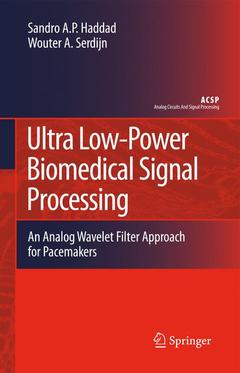Description
Ultra Low-Power Biomedical Signal Processing, 2009
An Analog Wavelet Filter Approach for Pacemakers
Analog Circuits and Signal Processing Series
Language: English
Subjects for Ultra Low-Power Biomedical Signal Processing:
Publication date: 10-2010
215 p. · 15.5x23.5 cm · Paperback
Approximative price 105.49 €
Subject to availability at the publisher.
Add to cartPublication date: 04-2009
Support: Print on demand
Description
/li>Contents
/li>Comment
/li>
Often WT systems employ the discrete wavelet transform, implemented on a digital signal processor. However, in ultra low-power applications such as biomedical implantable devices, it is not suitable to implement the WT by means of digital circuitry due to the relatively high power consumption associated with the required A/D converter. Low-power analog realization of the wavelet transform enables its application in vivo, e.g. in pacemakers, where the wavelet transform provides a means to extremely reliable cardiac signal detection.
In Ultra Low-Power Biomedical Signal Processing we present a novel method for implementing signal processing based on WT in an analog way. The methodology presented focuses on the development of ultra low-power analog integrated circuits that implement the required signal processing, taking into account the limitations imposed by an implantable device.




